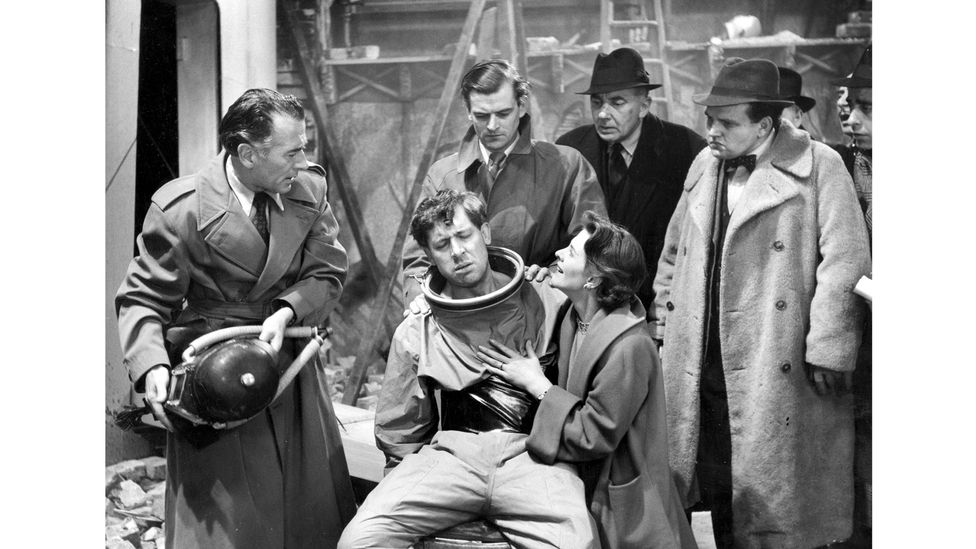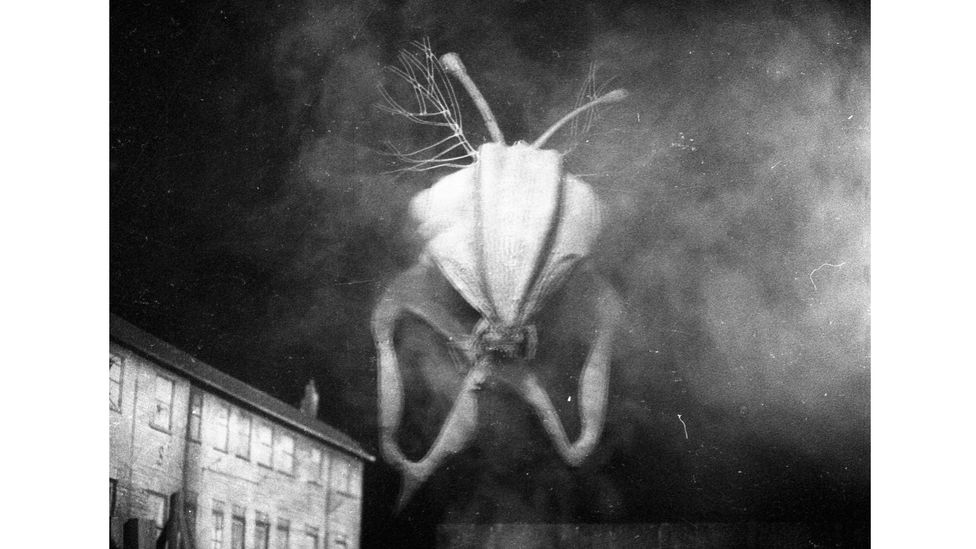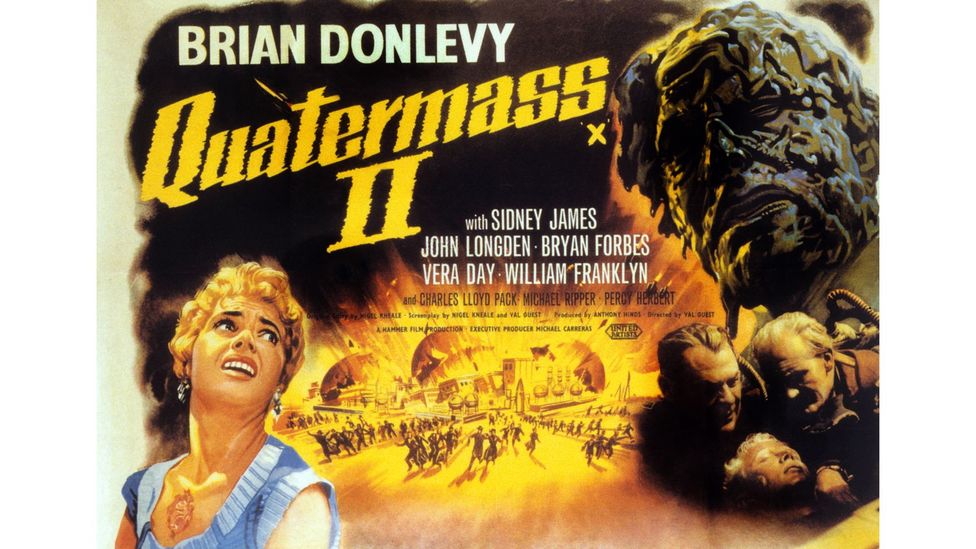The sci-fi show that terrified Britain

Today marks 100 years since the birth of a figure who may not be a household name, but who has greatly influenced 20th-Century film and television – British screenwriter Nigel Kneale. Having started his career in the late 1940s as an actor in radio, Kneale soon rose to prominence as one of the most in-demand writers in the UK, for both the big and small screen. His work covered a range of genres, from science fiction and horror to British kitchen sink and political dramas, becoming incredibly influential across generations – and so it is that his centenary has been celebrated with a season of his work at London’s BFI Southbank this month.
More like this:
– The greatest Star Trek episode ever?
– The historical roots of the ‘multiverse’
– The sci fi-stories that have become a reality
Out of Kneale’s many contributions to British screen culture, it is arguably his creation of the Quatermass television serials for the BBC in the 1950s that has left the most profound mark. Directed by the legendary Rudolph Cartier, the first of the serials, The Quatermass Experiment (1953), was also the first original adult science-fiction drama that the BBC had produced for television. The serials centred on the intrepid scientist Professor Bernard Quatermass – whose name was inspired by a surname discovered by chance in the telephone book and the astronomer Bernard Lovell – as he faces down a range of unusual extraterrestrial threats.

1953’s The Quatermass Experiment kicked things off with a story about an astronaut bringing something aggressively alien back to Earth (Credit: BBC)
Across six episodes, broadcast throughout the summer of 1953, The Quatermass Experiment, starring Reginald Tate as the professor, gripped the nation with the tale of an astronaut bringing something aggressively alien back to Earth. Today, only two episodes of the original serial are still viewable, since the show, as with other TV dramas back then, was performed and broadcast live, with the other episodes not recorded. It was followed by Quatermass II, broadcast in 1955, while the initial trilogy concluded in 1958 with the astonishing Quatermass and the Pit – both of these thankfully are still in existence in the BBC archives.
Throughout the 1950s, the Quatermass serials helped define the BBC’s drama output. They were one of the earliest examples of event television, providing for the young medium what we now know of as watercooler moments. Beyond the BBC, meanwhile, Kneale biographer Andy Murray believes the programmes set a new benchmark for British television more generally. “Quatermass wasn’t the only television drama [of the era] to have a sense of ambition,” he tells BBC Culture, “but I think it’s certainly a landmark example that surely made fellow programme makers sit up and pay attention. Quatermass serials were mainstream and popular. This wasn’t ‘genre television’ as a cult niche. They proved it could have a broad audience.”
Quatermass took science fiction and brought it to a captivated, not to say terrified, mass British audience, while innovating with the multi-camera format of the period, and creating something unique. Yet its imprint can be seen everywhere today, from its model of serialised drama to its themes of alien invasion, mysterious military establishments and unsettled landscapes. The shadow it cast was, indeed, long.
In creating overarching multi-episode storylines, the Quatermass serials were at the forefront of pioneering television’s use of the cliffhanger as a way to keep people coming back. Indeed, while the first episode achieved 3.4 million viewers, its final episode achieved closer to 5 million. It showed how a series could grow audiences over time, and proved to the BBC that serialised drama really worked, hooking viewers in a fast-changing TV landscape from week to week, who were desperate to know how it ended. Whereas the corporation had previously leaned towards producing single televised plays and dramas such as Jack Hulbert’s contribution to the Festival of Britain in 1951, The Golden Year, or various theatrical adaptations of Shakespeare, episodic drama was normalised after Quatermass.
In fact, Quatermass proved such a hit that before the second BBC serial had even aired, film adaptations of the scripts had begun – a franchise that kickstarted the legendary Hammer Studios’ successful turn towards the horror cinema they would become famous for. In 1955, The Quatermass Experiment was brought to the big screen by director Val Guest, and renamed The Quatermass Xperiment in order to celebrate its X certificate. This was followed by Guest’s Quatermass II in 1957 and Roy Ward Baker’s Quatermass and the Pit a decade later in 1967.

The Quatermass serials featured various strange beings and occurrences – while also suggesting they may be at the core of life on Earth (Credit: BBC)
In spite of the television serials’ popularity, the Quatermass Hammer films had an even more impactful influence on culture, especially abroad and in the US. “The likes of Stephen King, Joe Dante, John Landis and Dan O’Bannon grew up watching them and adored them,” Murray suggests. “There’s what looks suspiciously like a nod to the Quatermass and the Pit film at the climax of Steven Spielberg’s Raiders of the Lost Ark (1981). In Mexico, Guillermo del Toro was first exposed to Nigel Kneale though the Quatermass films too.”
Their unique dread
The cornerstone of Quatermass’s unique sci-fi vision was its quintessential Englishness. It depicted a simultaneously recognisable and surreally menacing version of the country in the post-war period, complete with copious “Keep Out” signs, villages that weren’t really villages, and Tube stations haunted by devilish Martian insects. “He took that feeling of an England that had become strange to itself and managed to turn it into a kind of mode, so people could name the unease that they felt in the 1950s,” says writer and broadcaster Matthew Sweet, an ardent fan of Kneale’s work. “And that name was Quatermass.”
This sense of a society askew was felt strongly in the second instalment, Quatermass II. It follows the professor (now played by John Robinson) investigating an alien presence in the town of Winnerden Flats. Meteorites are falling, and the local research laboratory has grown to such a suspiciously large size that the original town has been flattened for the prefabs for its many zombie-like workers. People are also showing unusual marks on their hands and are behaving increasingly oddly. Just what is growing in the great vats of the research laboratories?
“Quatermass lifts the stone and shows what’s crawling underneath the culture we occupy,” suggests Sweet. “It makes England a fit place for aliens to visit. I think Kneale, as well as John Wyndham, made England a suitable environment for them to transform.” Indeed, Kneale’s aliens often seem strangely at home in their new surroundings, ready to transform shabby 1950s England for their own unspeakable purposes.
The third serial, Quatermass and the Pit, provided an even more off-kilter perspective on everyday life in 1950s Britain. The aliens in this series have found their way to England again, but this time there’s a unique twist: the Martians, it transpires, might have been on Earth before us and, perhaps, it is we who are the aliens. Broadcast in 1958, the influence of Kneale’s third instalment can be seen in a great deal of television to come, in particular upon Doctor Who’s 1970s series starring Jon Pertwee, which were earthbound and dealt with similar narratives of para-military organisations protecting Britain from alien foes.
The excavation of a Martian craft from under a Tube station by Quatermass (now played by André Morell) and his team is one thing. But the way Kneale frames the implications of this is where his skill and influence as a writer really come to the fore. In his hands, the perception of our place in the world is knocked out of joint as fantastical futurisms become haunted folklore.
Indeed, throughout Kneale’s work, there’s a general sense of the folkloric. His galactic evils may occasionally foreshadow fears over the coming Space Age, but they often simultaneously seem ancient and haunting. They may be ostensibly associated with other planets, but they are also found to be already embedded within our physical, and psychic, landscapes.

The Quatermass TV serials were matched by film versions that kickstarted Hammer Studios’ turn towards horror (Credit: Alamy)
These stories also “took something that was in the atmosphere in England [at that time],” Sweet believes, “a sense of unease about the persistence of a war-time culture lasting into peace time, and what was going on in those establishments behind the fences. Kneale took that atmosphere of the post-war [period] descending into the Cold War, that feeling of growing estrangement.”
It is often the clash of the ordinary with the extraordinary that is taken as the key legacy of the Quatermass stories, in particular when it comes to their influence on the sci-fi and genre television that soon followed. “Great swathes of Doctor Who are haunted by Quatermass,” Sweet argues, “to the extent that I think Kneale thought he was really owed a cheque, at least for the early 1970s seasons. It also [has] a certain way of presenting England. You can see the influence in things like The Avengers with their villages that aren’t really villages at all, but training grounds for Communists.” Aside from Doctor Who and The Avengers, the strange atmospheres of Quatermass can be found in many other shows on both sides of the Atlantic in the decades since, from A for Andromeda to Doomwatch, Black Mirror to The X-Files. The list could go on.
Of course, it would be wrong to assume that the television shows themselves were wholly responsible for this influence. Arguably, it was Hammer’s film adaptations which brought harder, leaner versions of the Quatermass stories to a bigger audience. “Most people who have been aware of Quatermass since the 1950s are far more likely to have seen the film versions,” says Murray. “[They] have had a greater reach.” They are still, however, polished echoes of those grainy, television originals.
Ultimately, the importance of Quatermass today lies as much in it being a snapshot of those early days of the small screen as its subsequent influence. “It was perfectly attuned to the way you watched television in the 1950s,” Sweet concludes. “There was something séance-like about watching. You had to draw the curtains to see it, the television had to warm up, and then something manifested on a screen that was a bit like looking into the porthole of a Martian capsule. It captured people’s imaginations so powerfully and really haunted a whole generation.” The spirits that Quatermass summoned haunt us to this day, and Kneale’s serials are still arguably one of the most important television events in the history of the medium.
Love film and TV? Join BBC Culture Film and TV Club on Facebook, a community for cinephiles all over the world.
If you would like to comment on this story or anything else you have seen on BBC Culture, head over to our Facebook page or message us on Twitter.
And if you liked this story, sign up for the weekly bbc.com features newsletter, called The Essential List. A handpicked selection of stories from BBC Future, Culture, Worklife and Travel, delivered to your inbox every Friday.








